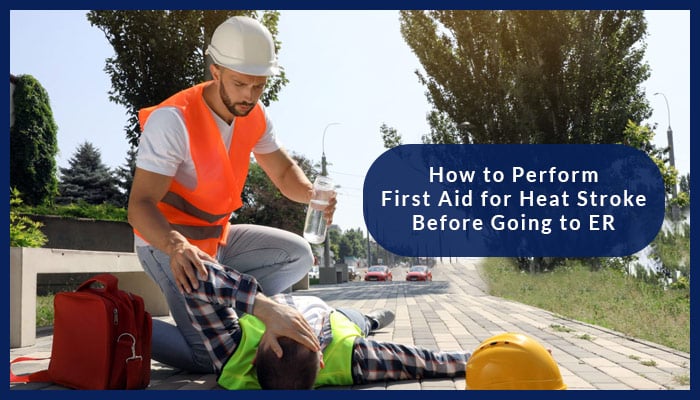Heat stroke is a life-threatening condition that occurs when the body’s core temperature rises to dangerously high levels. It’s a medical emergency that requires immediate attention. While professional medical help is essential, knowing how to perform first aid for heat stroke before reaching the emergency room can make a critical difference in the outcome. In this guide, we will explore the steps to take when dealing with heat stroke.
Understanding Heat Stroke
Before diving into first aid Heat Stroke, it’s crucial to understand what heat stroke is. Heat stroke occurs when the body’s cooling mechanisms fail, and the core temperature rises above 104 degrees Fahrenheit (40 degrees Celsius). This can lead to organ damage, and in severe cases, it can be fatal.
Recognizing the 10 Symptoms of Heat Stroke
High Body Temperature
The primary symptom of heat stroke is a significantly elevated body temperature. The person’s skin will feel hot and dry to the touch.
Altered Mental State
Heat stroke can cause confusion, agitation, slurred speech, irritability, delirium, or even loss of consciousness.
Rapid Heartbeat and Breathing
An individual with heat stroke may have a strong and rapid pulse and breathing rate.
Nausea and Vomiting
Nausea and vomiting are common symptoms, which can lead to dehydration.
Skin Changes
The skin may appear red and flushed, particularly in the face.
Steps for First Aid for Heat Stroke
Call 911
The first and most crucial step is to call for emergency medical assistance. Heat stroke is a medical emergency, and the person needs professional help as soon as possible.
Move to a Cooler Place
If possible, move the person to a cooler, shaded area. Getting out of the direct sun is vital.
Cool the Person
Use any means available to cool the person down. You can use cool water, a damp cloth, or a sponge. Applying cold packs to the neck, armpits, and groin can be especially effective. Fan the person to increase the cooling effect.
Hydrate
If the person is conscious and able to swallow, provide cool, non-alcoholic, non-caffeinated beverages. Water is best, but oral rehydration solutions can also help.
Remove Excess Clothing
If it’s safe to do so, remove any unnecessary clothing to allow for better heat dissipation.
Monitor Vital Signs
While waiting for emergency services, monitor the person’s vital signs. Look for signs of improvement or deterioration in their condition. If they lose consciousness, check for breathing and start CPR if necessary.
Do Not Use Ice
Avoid using ice or very cold water for cooling. This can constrict blood vessels and prevent heat from escaping the body.
Do Not Offer Food or Drink If Unconscious
If the person becomes unconscious, do not try to give them fluids by mouth, as it can lead to choking.
Conclusion
Knowing how to perform first aid for heat stroke can be a lifesaver in critical situations. However, always remember that heat stroke is a medical emergency, and professional medical assistance is essential. Prompt action and awareness of the symptoms can significantly improve the chances of a positive outcome.
FAQs
Q: Can you treat heat stroke at home without medical help?
No, it is a medical emergency. While you can administer first aid for heat stroke, professional medical assistance is crucial for proper treatment.
Q: What’s the difference between heat exhaustion and heat stroke?
Heat exhaustion is a milder condition that can progress to heat stroke. Heat stroke is more severe and can be life-threatening.
Q: Can heat stroke lead to permanent damage?
Yes, heat stroke can cause organ damage if not treated promptly. Brain damage, kidney problems, and other complications can occur.
Q: Are certain individuals more at risk for heat stroke?
Yes, the elderly, young children, athletes, and those with certain medical conditions are at higher risk.
Q: How can you prevent heat stroke?
Staying hydrated, avoiding excessive heat, and taking breaks in the shade can help prevent heat stroke.
Q: Can you drive a heat stroke victim to the hospital?
It’s safer to call 911 and wait for professional medical assistance. They can provide the necessary care during transportation.






